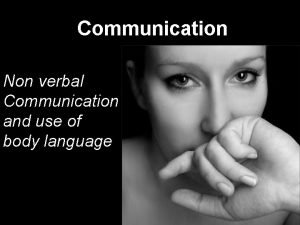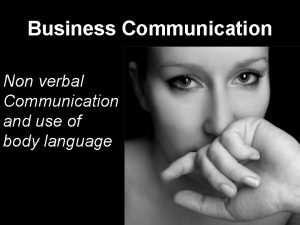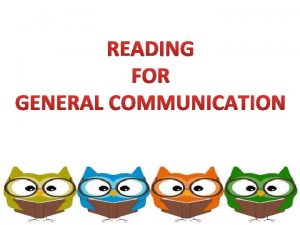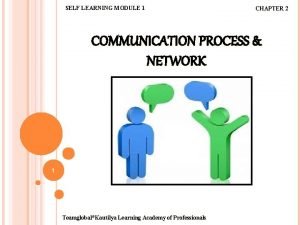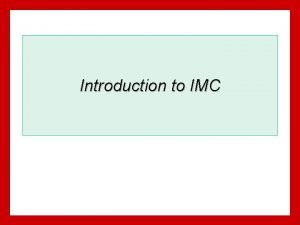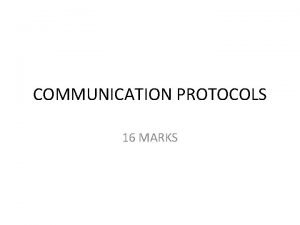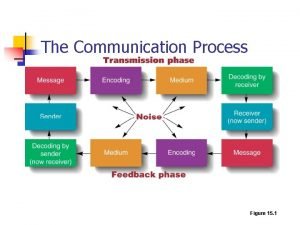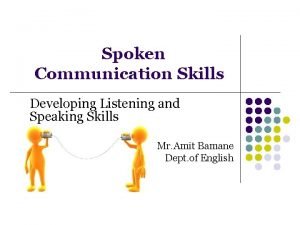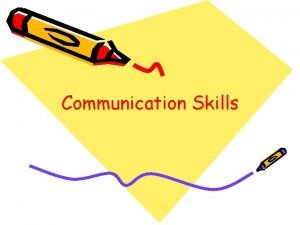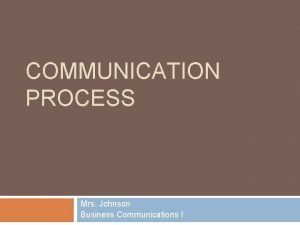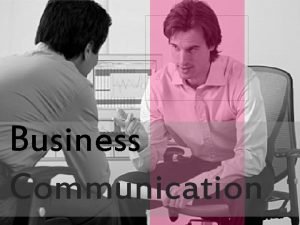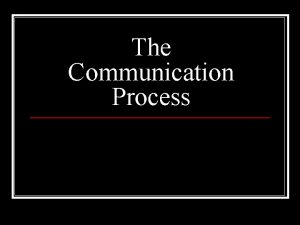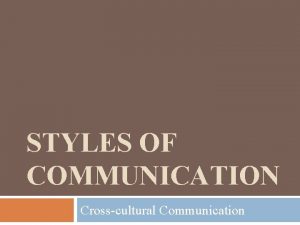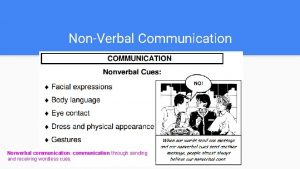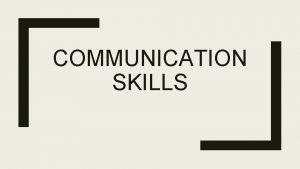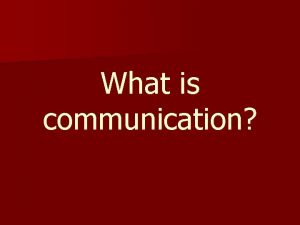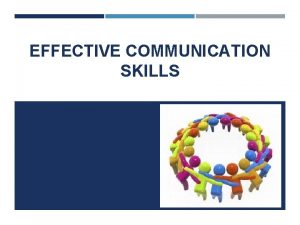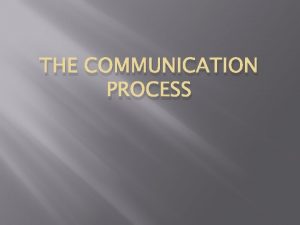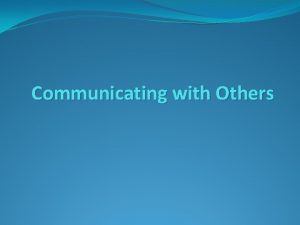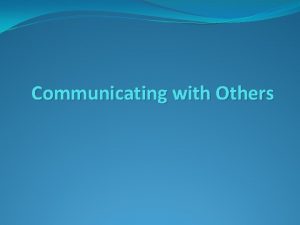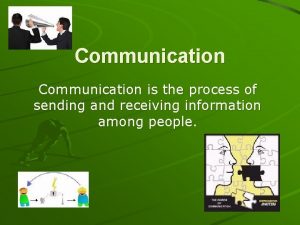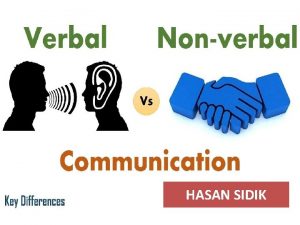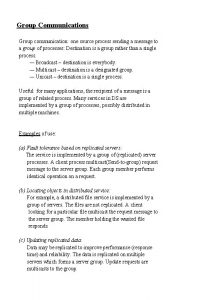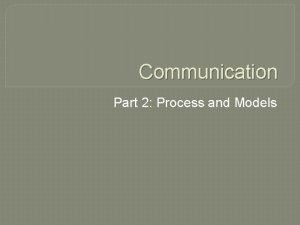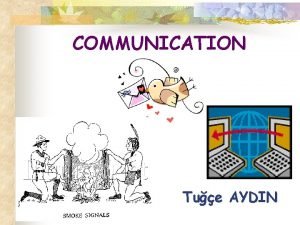Communication in general is process of sending and








































- Slides: 40

Communication in general is process of sending and receiving messages that enables humans to share knowledge, attitudes, and skills. Although we usually identify communication with speech, communication is composed of two dimensions - verbal and nonverbal.

Non-verbal Communication

Non-verbal Communication As human beings, over 90% of what we communicate is done through nonverbal channels.

Nonverbal communication has been defined as communication without words. It includes behaviors such as facial expressions, eyes, touching, and tone of voice, as well as less obvious messages such as dress, posture and spatial distance between two or more people.

Everything communicates, including material objects, physical space, and time systems. Although verbal output can be turned off, nonverbal cannot. Even silence speaks.

No matter how one can try, one cannot communicate.

Commonly, nonverbal communication is learned shortly after birth and practiced and refined throughout a persons lifetime. Children first learn nonverbal expressions by watching and imitating, much as they learn verbal skills.

Young children know far more than they can verbalize and are generally more adept at reading nonverbal cues than adults.

It is estimated that there are over 200, 000 physical signs capable of stimulating meaning in another person (some social scientists state even 700, 000). For example, there are 23 distinct eyebrow movements, each capable of stimulating a different meaning.

Humans use nonverbal communication because: 1. Words have limitations: There are several ways where nonverbal communication is more effective than verbal 2. Nonverbal signals are powerful: Nonverbal cues usually express inner feelings 3. Nonverbal messages are likely to be more real: because nonverbal behaviors cannot be controlled as easily as spoken words. 4. Nonverbal signals can express feelings inappropriate to say aloud: Social etiquette limits what can be said, but nonverbal cues can communicate thoughts. 5. A separate communication channel is necessary to help send complex messages

FACIAL EXPRESSION

Facial expressions may be unintentional or intentional. Next to words, the human face is the primary source of information for determining an individuals internal feelings.








EYES

The most dominant and reliable features of the face is the eyes. Eyes provide a constant channel of communication.

Referred to as the windows to the soul, the eye serve as the major deciding factor in interpreting the spoken word.


. Eyes also can accurately indicate a positive or a negative relationship. People tend to look longer and more often at those, whom they trust, respect and care about than at those whom they doubt or dislike.

Researches show that a speaker who looks at an audience is perceived as Much more ; Favorable, Confident Credible, Qualified, Honest, Less Nervous

People Communicate by the way they walk, stand, and sit.

Distance! 1. Intimate distance - from actual touching to eighteen inches. This zone is reserved for those with whom one is intimate. 2. Personal distance from eighteen inches to four feet. This is the distance of interaction of good friends. 3. Social distance exists from four to twelve feet. It seems to be an appropriate distance for casual friends and acquaintances to interact. 4. Public distance outward from twelve feet a speaker becomes formal.

TOUCH

Parents transmit feelings to an infant physically, not verbally.

Touching can give encouragement, express tenderness, and show emotional support


Appearance






Symbols

Non verbal/ persuasion techniques quiz 1. How much of our communication is done through non verbal channels? 2. How many gestures (approximate) do we use to communicate? 3. What is/are the most dominate and reliable features of the face that provide a constant channel of communication? 4. I gave you 5 reasons we use nonverbal communication, name 3 reasons. 5. What are the 4 distances we use for communication? 6. Looking directly at the person you are communicating with is called what? 7. All of our physical movements are called what? 8 No matter how one can try, one cannot _________. 9. What is the definition of nonverbal communication? 10 A speaker who looks at the audience is perceived to be more ____.

ANSWERS 1. How much of our communication is done through non verbal channels? A: OVER 90% 2. How many gestures (approximate) do we use to communicate? A: 200, 000 3. What is/are the most dominate and reliable features of the face that provide a constant channel of communication? A: EYES 4. I gave you 5 reasons we use nonverbal communication, name 3 reasons. A: Words have limitations, Non-verbal powerful, necessary for complex messages, inappropriate to say aloud, more reality than words 5. What are the 4 distances we use for communication? A: Intimate, Personal, Social, Public 6. Looking directly at the person you are communicating with is called what? A: Eye Contact 7. All of our physical movements are called what? A: Gestures 8 No matter how one can try, one cannot A: NOT COMMUNICATE 9. What is the definition of nonverbal communication? COMMUNICATING WITHOUT WORDS DUH! 10 A speaker who looks at the audience is perceived to be more A: CREDIBLE, HONEST, CONFIDENT, FAVORABLE
 Sending or receiving information
Sending or receiving information Communication in general is process of sending
Communication in general is process of sending Sending and receiving signals are special constructs of
Sending and receiving signals are special constructs of Communication in general is process
Communication in general is process Brisk erect walk
Brisk erect walk Business letter purpose
Business letter purpose Sequence diagram for sending email
Sequence diagram for sending email Sample email for sending resume
Sample email for sending resume Sending synonyms
Sending synonyms Data-sending trojan
Data-sending trojan Send forth prayer
Send forth prayer Importance of technical writing
Importance of technical writing Planos en cinematografia
Planos en cinematografia Where did general lee surrender to general grant?
Where did general lee surrender to general grant? What is oral communication and written communication
What is oral communication and written communication Meaning of oral communication
Meaning of oral communication Parallel communication examples
Parallel communication examples Reading for general communication
Reading for general communication Technical communication: process and product
Technical communication: process and product Communication process and elements
Communication process and elements The process of communication and with
The process of communication and with Dfd ch 16
Dfd ch 16 General design process
General design process Bones practical exam
Bones practical exam Condylar and coronoid process of mandible
Condylar and coronoid process of mandible Parallel serial port
Parallel serial port What is mass communication
What is mass communication Serial communication vs parallel communication
Serial communication vs parallel communication Linear and interactive models of communication
Linear and interactive models of communication Communication process figure
Communication process figure Listening communication
Listening communication Process communication model
Process communication model Communication is unavoidable
Communication is unavoidable Communication is a cyclic process
Communication is a cyclic process Einflussfaktoren der kommunikation
Einflussfaktoren der kommunikation Sales communication skills
Sales communication skills Steps of communication process
Steps of communication process Retail communication process
Retail communication process Business communication objective
Business communication objective Semantic barriers
Semantic barriers Communication is unavoidable
Communication is unavoidable



